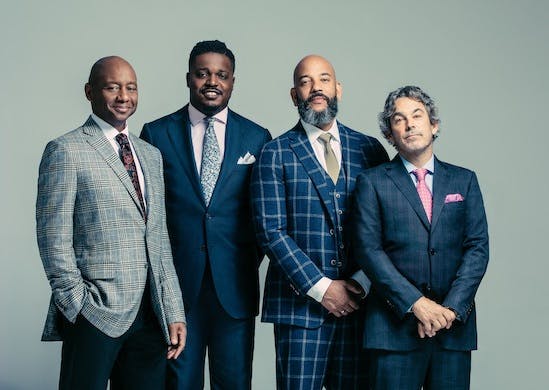Longevity Is One of the Secrets of the Branford Marsalis Quartet
The four members are empowered by knowing each other’s ‘poker playing habits,’ in the ever-quotable Duke Ellington’s memorable phrase.

Branford Marsalis Quartet
‘The Secret Between the Shadow and the Soul’
Sony Masterworks (2019)
If you look up the title of saxophonist Branford Marsalis’s latest album on Apple Music, you won’t find it. The only way to do so is to search for “Branford Marsalis Quartet.” Part of me wants to object to this, because it’s surely going to cost Mr. Marsalis some revenue, and more so because interested listeners might miss the chance to enjoy this excellent album.
Upon reflection, though, this makes a lot of sense: “Secret” is much more of a quartet effort than it is the product of an individual musician, a point underscored by Mr. Marsalis’s quartet last Thursday with a concert at 92NY that included much of the music from the album.
Musicians these days frequently change partners and collaborators, which is often the only option in this economic climate for music. Flying in the face of that, Mr. Marsalis has been notably successful in keeping together his rhythm section. He goes back more than 10 years with both bassist Eric Revis and drummer Justin Faulkner, and at least 30 with pianist Joey Calderazzo.
The long-running nature of the group gives it an obvious synergy. Although the quartet played everything from bebop to New Orleans bar music at the Y, its major template is the Modern Jazz Quartet. The way that the four members know each other’s “poker playing habits,” in the ever-quotable Duke Ellington’s memorable phrase, empowers them to create music that sounds more appropriate for a concert hall.
This is music that you listen to without a drink in your hand or a burger in front of you, and that’s truly the legacy of the MJQ.
When four musicians just get together somewhat randomly, the normal order of business is usually to play familiar melodies and run chord changes. With a more or less permanent group like the BM4, the stakes are higher. The leader isn’t just calling tunes, but the whole program is more meaningfully organized. Each tune has a clearly defined trajectory, a beginning, a middle, and a conclusion — and, what’s more, so do all the individual solos within each piece.
It’s characteristic of a higher level of organization that many of the pieces start with Mr. Marsalis stating the melody briefly, and Mr. Calderazzo improvising at length before Mr. Marsalis returns to play his full solo.
What’s more, the degree of comfort that they have with each other empowers them to keep collectively adjusting each number as it progresses, so it shifts subtly within the tune itself. The opening number, “Mighty Sword” (which also opens the quartet’s 2012 album, the provocatively titled “Four MFs Playin’ Tunes”), is a bright bopper, with the leader playing soprano saxophone. It starts out excitingly choppy and staccato, but gradually grows smoother and more legato.
Mr. Marsalis stayed on soprano for the second number (also in the no. 2 spot on “Secret”), Mr. Calderazzo’s “Conversation Among the Ruins.” This is more like traditional concert music — of the classical or chamber music sort. Not exactly a ballad, it’s a tranquil, ruminative, even meditative piece. Conversely, this one starts out smooth and legato but gets more intense and unsettled as it reaches the conclusion.
Both the Y concert and the current album wound up with “The Wind Up,” a composition by Keith Jarrett. While that world-renowned pianist is generally celebrated for his introspective performances, this is a raucous piece of 1960s-style soul jazz, like something lifted from a Holy Roller revival meeting or one of Lee Morgan’s funk riffs (think “The Sidewinder” or “The Rumproller”). It brought the concert to a rabble-rousing finale.
After leaving the stage, the foursome returned for an ancient New Orleans bar-room blues, “My Bucket’s Got A Hole In It.” This is known to every band both inside and outside of Preservation Hall, a rare song performed definitively by both Louis Armstrong and Hank Williams. By this point, the crowd was so elevated that we all spontaneously began clapping and chanting.
Even before then there was one other number that was something other than an original by the band. This was “When I Take My Sugar to Tea,” a 1931 pop tune recorded by, among many others, jazz monarchs such as King Oliver and Nat King Cole. The quartet’s performance of this bouncy and ebullient number was something I don’t ever remember hearing before: full-on modern jazz, with all the sonic earmarks of real bebop, but somehow situated within a 1920s-style two-beat.
When he introduced the number, Mr. Marsalis told the crowd, “I don’t know who wrote it.” Someone yelled out, “Sammy Fain.” I swear it wasn’t me; it was some other bald guy who happened to be sitting in my seat.

